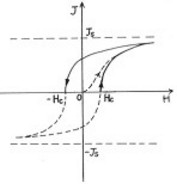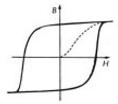Physics reminder: magnetic media
Introduction
Magnetic material with properties lending themselves to magnetization in the Tesla range are of special interest when working in an electromagnetic application.
Material properties
A few material have favorable electronic characteristics. They posses three common properties:
- their atoms have magnetic moments : transition elements (Fe, Ni, Co...) or rare-earth elements (Nd, Sm, Gd, Dy...);
- the magnetic moments of neighboring atoms orient themselves parallel to the others. This is called ferromagnetic, antiferromagnetic, or ferrimagnetic behavior;
- the interactions of magnetic moments are sufficiently strong to resist thermal agitation. In fact, there is always a thermal limit, the Curie temperature, above which the magnetic moments disorder prevales.
Magnetization law
A magnetic material does not magnetize itself spontaneously. We have to provide magnetization energy by applying an exciting magnetic field H.
- Js saturation magnetization correspond to the alignment of all magnetic moments as perfect as possible at a given temperature.
- The Hc coercive field is linked with the magnetocrystalline anisotropy.

Hard and soft magnetic materials: definition
In some materials, the magnetic moments turn easily and a small excitation field is sufficient to modify the local value of magnetization. These are called soft magnetic materials.
On the contrary, if the anisotropy is significant, magnetic moments are blocked in the easily magnetized direction and remain insensitive to the action of an exterior magnetic field. these are called hard magnetic materials.
The magnetization laws of these materials are presented below.
| Hard magnetic material (permanent magnet) | Soft magnetic material |
|---|---|
 |
 |
| Coercive field > 1000 A/m | Coercive field < 1000 A/m |
Hard and soft magnetic materials
- In most of their applications, soft magnetic materials are used in AC magnetic fields. The hysteresis loop is described permanently; our interest is to have a small coercive field in order to reduce losses.
- Hard magnetic materials are used as sources of static magnetic fields. Once magnetized, the aquired magnetization must be preserved whatever the external influences might be. The higher the coercitive field is the better they perform.